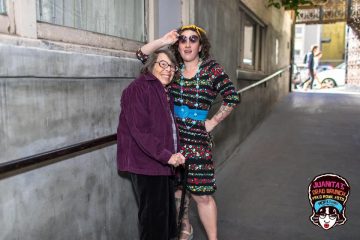SF Chronicle Investigation Reveals Nothing About SF Homeless Problem…Again
By Matthew Gerring
For the second year in a row, the San Francisco Chronicle’s Heather Knight kicked off the SF Homeless Project with a splashy front-page article in which the voices of homeless people are nearly absent.
Last year’s lead article used innovative data-driven reporting to illustrate how annoying homeless people are (but not the size of the shelter waiting list, for which data are readily available). This year, Knight did some traditional shoe-leather reporting, and went to a street in SOMA to interview people about how annoying homeless people are.

Knight framed her story as an attempt to give “regular people” a voice, she writes:
“Some of the city’s biggest names — from San Francisco Travel to the Chamber of Commerce to the Hotel Council — have loudly protested the disastrous conditions on San Francisco’s sidewalks in recent months, and regularly get meetings with City Hall politicians, but the voices of everyday residents aren’t always heard.
The ones just trying to raise kids, work and, well, live. The ones with so little power, they can’t get their supervisors to respond to their requests for help. The ones with the misery literally on their front doorsteps.”
In other words, Knight is speaking up for the ‘little guy’ who is complaining about homeless people, who is not always heard over the fat cats, who are making the exact same complaints about homeless people.
The “misery” she writes about belongs exclusively to the aggrieved middle class, the people who have to look at homeless people from their windows and front porches, but never the homeless people themselves. The suitcase full of feces that anchors this article is scandalous because a person with regular access to a toilet found it, not because human beings are forced to use it for lack of a better option.
Luckily, some of Knight’s interview subjects do the moral work she’s not willing to:
“I really strongly believe San Francisco is for everybody, not just us, but the community should be livable for everybody,” said Schoen-Rene’s wife, Jill, an attorney and children’s book author. “The suitcase is a symbol. Nobody should have to poop in a suitcase, and nobody should have to find a suitcase full of poop.”

Photo courtesy of Homeless in Savannah.
But the quote is there to prove to the audience that these people “aren’t get-off-my-lawn types,” that they’re in fact “very progressive and genuinely heartsick.”
Knight doesn’t bother to seriously interview any of the homeless people on Isis street. This is the only instance where Knight lets a homeless person speak:
A man with a pile of belongings and a dog nestled in an open suitcase stood nearby. He said his name is just Roni and he’s been homeless for eight years. He said he’s addicted to meth. His teeth seemed to be disintegrating.
“It’s a hard way to live. There’s a lot of stress,” he said, talking loudly over the sound of whizzing traffic above. “I just want to be somewhere where I can relax. Sleep maybe.”
Not a word about why Roni is homeless, where he was living before, why he ended up on Isis street, how he’s been affected by shifting policies and enforcement, his responses to his neighbors complaints, which are taken by Knight at face value. Nothing.
In the next paragraph, as if by magic, Roni disappears!
Weeks later, people like Roni were gone. Mayor Farrell had directed the clearing of the remaining tents in the area, emphasizing that those living inside had been offered services and shelter repeatedly and had declined...He doesn’t know where those who didn’t accept shelter went — and the Farrell administration hasn’t bothered to track them.
“It’s as if they all got raptured,” Schoen-Rene said…Schoen-Rene is a 46-year-old computer programmer who lives in a house near Isis Street, which stretches just a block from 12th to 13th streets on the edge of South of Market near the Mission District border.
Man. What a mystery. If only there were some institution whose job it was to investigate claims made by the government, some storied, award-winning institution, with its name on a building downtown, that had the resources to track down any one of the missing people and ask them what happened.

The San Francisco Chronicle building (Photo by Julian Dunn via Flickr)
I was also curious where the homeless people on my block ended up. I was personally out of town for Mark Farrel’s Homeless Rapture, and when I returned a few weeks ago, the homeless people living on my block I recently wrote about had disappeared.
Since it looked like nobody at the Chronicle was going to satisfy my curiosity, I decided to do their jobs for them and track one of my old neighbors down.
I found Ellie May, one of a few people who regularly slept outside my apartment until recently, just a few blocks from my building at the mouth of the Panhandle with her dog, Orion.
“I’m actually doing pretty good for myself right now,” she said. She and a friend came up with $500 for a down payment on a van (she said she got the money partly from a bunch of coins she found in a dumpster, and I’m taking her word for it), and she said she’d be moving into it in a few days.
Ellie May, who is 23, has been homeless since she arrived in San Francisco three years ago. This is uncommon for homeless people in San Francisco, 70% of whom were housed here before becoming homeless, but it’s more common in the Haight, which is a destination for young people from all over the world.
She said she left her home in Florida at 19 to travel to Rainbow Family gatherings. She’s since settled down, except for a 6-month stretch where she went home to Florida to help her dad. She’s stayed near Golden Gate Park the whole time she’s lived here.

Golden Gate Park at night
She ended up sleeping and hanging out where she did, on a small concrete median where Golden Gate Park meets the Panhandle, in part because of increased pressure on homeless youth by park rangers.
She said her and her friends’ belongings were frequently stolen and thrown in a dumpster, and that she lost count of the number of times she’s climbed a fence to retrieve them. She also said there are fewer and fewer hidden places to sleep in the park because city workers keep cutting the bushes back where they catch homeless people sleeping.
She said the median was much safer, because Department of Public Works crews are more lax than park rangers, and are only interested in throwing away trash. And she said she was led to believe the median in front of my apartment building was park property, so she wouldn’t get a Sit/Lie citation there.

Department of Public Works crews. photo http://eltecolote.org
She did get those citations though, on the few occasions my neighbors called the police. Their complaints weren’t about people sleeping on their street, but about more extreme and troubling behavior.
Ellie May’s now ex-boyfriend, who wouldn’t give me his name the few times I spoke with him, kept bringing larger and larger pieces of furniture onto the sidewalk. He, his friends and their dogs would congregate around the chairs or couches and smoke, drink, get rowdy, and, yes, occasionally defecate.
The few times I asked him to stop it, he told me the sidewalk was his living room, and that I should be grateful that he let me pass. The residents in my building had a long-running 311 complaint about the encampment, and sometimes furniture would disappear, only to be replaced by other furniture a few days later.
It took two more straws to break the camel’s back. The first was when Ellie May’s friends broke an electrical box they were using for power on the building adjacent to mine. The building owners installed harsh floodlights that made it much more difficult to sleep anywhere nearby.
The second was that Ellie May broke up with her boyfriend, in part for being so inconsiderate of the other neighbors on the block.
“I like to be comfortable too,” she said, but her boyfriend took things too far. She said he’s now staying somewhere around a grocery store in the Sunset, and she’s happy to be moving into the van.
“I’m not someone who wants to sleep on the streets forever,” she said. “I love my life, I choose to be this way, but I want to be somebody, or help people.”
She said she’d happily move inside if she could, but she hasn’t found the opportunity, not for a lack of trying:
“I’ve applied for housing more than a few times, even when I was pregnant, before I had a miscarriage. And I still didn’t qualify. I’m healthy, I’m functioning, I’ve never been to a psychiatrist and been deemed crazy and incapable of functioning… I’m pretty much normal.”
And here’s the thing: she is pretty much normal.
I was also homeless at 23. In the summer of 2011, I was couchsurfing through an internship in Washington D.C., where they weren’t paying me enough to afford housing. I came back to school at San Jose State without a place to stay. I kept couchsurfing until I signed a lease for a room about a month into the semester. I was also homeless at 18, after getting thrown out of my parents’ house.
It’s different than Ellie May’s story, but only by degrees.
Like me, she doesn’t have a regular job, but she’s not broke. “There’s way more out-of-the-box ways to make money,” she said, which sounds a lot like that awful plague of transit ads for Fiverr.
The "gig economy" is literally killing us.
Most depressing ad of the day goes to: @fiverr ? pic.twitter.com/xq0sxsL55t
— it's B! Cavello ? (@b_cavello) March 9, 2017
She said she doesn’t want to live on the government’s dime. Contrast that with my deadbeat, medicaid-and-EBT-having ass.
Ellie said she smokes meth, in part because she said without it, she’d run herself ragged with all of the things she has to manage living outside. And if you think people taking amphetamines to handle everyday stress is weird, canvass your software engineer friends, or just check out the recent Netflix documentary on Adderall abuse.
Ellie May and I even have the exact same reason for deciding to hang on in a city that feels like it’s intent on driving out everyone except for the extremely wealthy:
“I love it here. It’s my home. The people I’ve met here in my life are some of the most beautiful people. When you love something enough you’ll do anything that you have to to keep that. I’m not just gonna bow out and be like ‘oh, well you know it’s easier or cheaper to stay somewhere else’, because I’d probably be miserable.”

A lot of people are struggling to hang on to their lives in San Francisco. Everyone has an opinion on who has it the hardest, and it almost always depends on their position in the socioeconomic hierarchy.
But it’s all the same struggle, whether it’s the struggle to get off the street, or into a better room with saner roommates, or into your own place where you don’t have to deal with anyone else’s dirty dishes, or into a house that’s not getting swamped by all-cash offers, or into another house that’s actually big enough for your family.
We love choosing a point on this spectrum and deciding that everyone else is either above and below us. We love saying “I think there’s room for everyone in this city, except those people.”
The SF Homeless Project, and the Chronicle in particular, are mainly punching down at homeless people from a middle-class perspective, divorcing the Bay Area’s homelessness problem from the broader context of our housing shortage. Here’s Knight again, in an article from 2016, “busting the myth” that homeless people are people just like everyone else:
Last year’s count found 25 percent of the city’s homeless wound up on the streets because of a lost job and 13 percent because of an eviction. But alcohol, drug use, a falling-out with family or friends, and divorce added up to the rest…
I can’t fathom what would have to happen in my life to put me on the streets, but it would take far more than one lost paycheck. A lot of family and friends would have to turn me away. And you’re probably the same.
I feel like if you can’t fathom losing a job, getting evicted, having a disability or a mental illness, or being addicted to drugs or alcohol, you should probably get out more. I’ve experienced several of these or have friends who have, and you probably do too. Even when writers like Kevin Fagan actually put in the work to talk to homeless people, they don’t put in the work to help people see how they, too, could end up in the same position as a homeless person. And for this reason, the project isn’t nearly as helpful as it could be.
All of us need to do the work to make room for all of us, and that burden needs to fall more heavily on the shoulders of people with more power, like people with access to massive media platforms. There’s enough room.
We don’t have to build walls, or kick people out, or give the government new powers to take people’s rights away and snatch them off the street, like the plan London Breed campaigned on and Scott Weiner introduced in the California legislature.
That’s not what San Francisco is about. Right?









